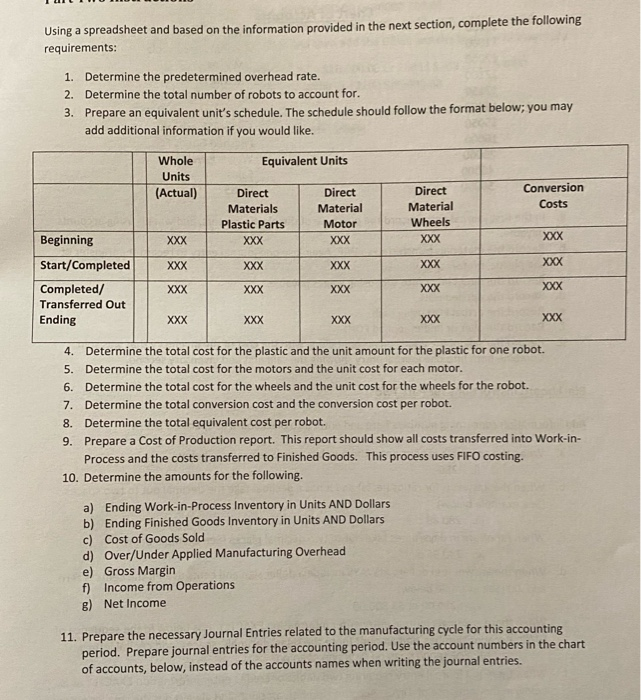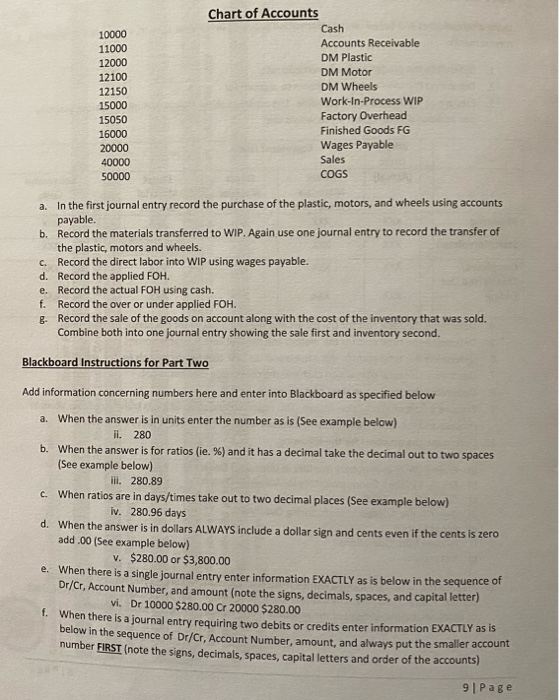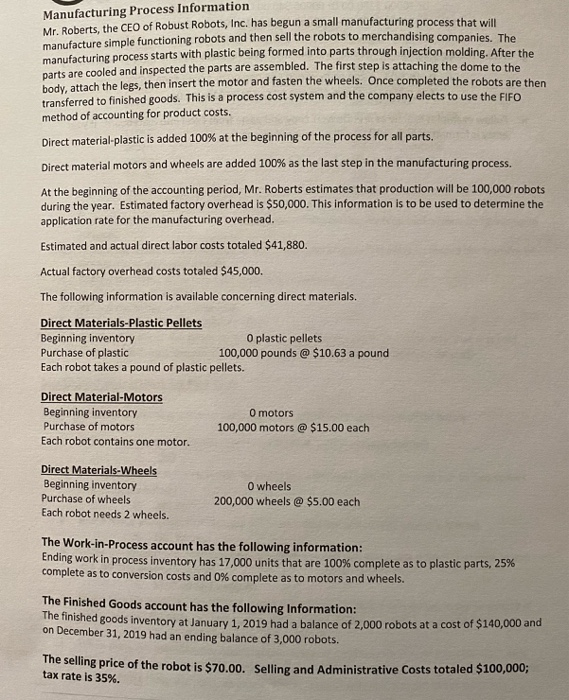Answered step by step
Verified Expert Solution
Question
1 Approved Answer
isnt the amounts the third picture? Using a spreadsheet and based on the information provided in the next section, complete the following requirements: 1. Determine



isnt the amounts the third picture?
Using a spreadsheet and based on the information provided in the next section, complete the following requirements: 1. Determine the predetermined overhead rate. 2. Determine the total number of robots to account for. 3. Prepare an equivalent unit's schedule. The schedule should follow the format below; you may add additional information if you would like. Equivalent Units Whole Units (Actual) Conversion Costs Direct Materials Plastic Parts XXX Direct Material Motor XXX XXX Direct Material Wheels XXX XXX xxx Beginning Start/Completed Completed/ Transferred Out XXX xox XXX XXX XXX xoxox xox Ending XXX XXX XXX xxx 4. Determine the total cost for the plastic and the unit amount for the plastic for one robot. 5. Determine the total cost for the motors and the unit cost for each motor. 6. Determine the total cost for the wheels and the unit cost for the wheels for the robot. 7. Determine the total conversion cost and the conversion cost per robot. 8. Determine the total equivalent cost per robot. 9. Prepare a Cost of Production report. This report should show all costs transferred into Work-in- Process and the costs transferred to Finished Goods. This process uses FIFO costing. 10. Determine the amounts for the following. a) Ending Work-in-Process Inventory in Units AND Dollars b) Ending Finished Goods Inventory in Units AND Dollars c) Cost of Goods Sold d) Over/Under Applied Manufacturing Overhead e) Gross Margin f) Income from Operations B) Net Income 11. Prepare the necessary Journal Entries related to the manufacturing cycle for this accounting period. Prepare journal entries for the accounting period. Use the account numbers in the chart of accounts, below, instead of the accounts names when writing the journal entries. 10000 11000 12000 12100 12150 15000 15050 16000 20000 40000 50000 Chart of Accounts Cash Accounts Receivable DM Plastic DM Motor DM Wheels Work-In-Process WIP Factory Overhead Finished Goods FG Wages Payable Sales COGS a. In the first journal entry record the purchase of the plastic, motors, and wheels using accounts payable. b. Record the materials transferred to WIP. Again use one journal entry to record the transfer of the plastic, motors and wheels. c. Record the direct labor into WIP using wages payable d. Record the applied FOH. e. Record the actual FOH using cash. f. Record the over or under applied FOH. g. Record the sale of the goods on account along with the cost of the inventory that was sold. Combine both into one journal entry showing the sale first and inventory second. Blackboard Instructions for Part Two Add information concerning numbers here and enter into Blackboard as specified below a. When the answer is in units enter the number as is (See example below) ii. 280 b. When the answer is for ratios (ie. %) and it has a decimal take the decimal out to two spaces (See example below) iii. 280.89 c. When ratios are in days/times take out to two decimal places (See example below) iv. 280.96 days d. When the answer is in dollars ALWAYS include a dollar sign and cents even if the cents is zero add.00 (See example below) V. $280.00 or $3,800.00 e. When there is a single journal entry enter information EXACTLY as is below in the sequence of Dr/Cr, Account Number, and amount (note the signs, decimals, spaces, and capital letter vi. Dr 10000 $280.00 Cr 20000 $280.00 1. When there is a journal entry requiring two debits or credits enter information EXACTLY as is below in the sequence of Dr/Cr, Account Number amount, and always put the smaller account number FIRST (note the signs, decimals, spaces, capital letters and order of the accounts) 9 | Page Manufacturing Process Information Mr. Roberts, the CEO of Robust Robots, Inc. has begun a small manufacturing process that will manufacture simple functioning robots and then sell the robots to merchandising companies The manufacturing process starts with plastic being formed into parts through inie parts are cooled and inspected the parts are assembled. The first step is attaching the dome to the hodv. attach the legs, then insert the motor and fasten the wheels. Once completed the robots are then transferred to finished goods. This is a process cost system and the company elects to use the FIFO method of accounting for product costs. Direct material plastic is added 100% at the beginning of the process for all parts. Direct material motors and wheels are added 100% as the last step in the manufacturing process. At the beginning of the accounting period, Mr. Roberts estimates that production will be 100.000 robots during the year. Estimated factory overhead is $50,000. This information is to be used to determine the application rate for the manufacturing overhead. Estimated and actual direct labor costs totaled $41,880. Actual factory overhead costs totaled $45,000. The following information is available concerning direct materials. Direct Materials-Plastic Pellets Beginning inventory O plastic pellets Purchase of plastic 100,000 pounds @ $10.63 a pound Each robot takes a pound of plastic pellets. Direct Material Motors Beginning inventory Purchase of motors Each robot contains one motor. O motors 100,000 motors @ $15.00 each Direct Materials-Wheels Beginning inventory Purchase of wheels Each robot needs 2 wheels. O wheels 200,000 wheels @ $5.00 each The Work-in-process account has the following information: Ending work in process inventory has 17.000 units that are 100% complete as to plastic parts, 25% complete as to conversion costs and 0% complete as to motors and wheels. The Finished Goods account has the following Information: The finished goods inventory at January 1, 2019 had a balance of 2,000 robots at a cost of $140,000 and on December 31, 2019 had an ending balance of 3,000 robots. selling price of the robot is $70.00. Selling and Administrative Costs totaled $100,000; tax rate is 35%. Using a spreadsheet and based on the information provided in the next section, complete the following requirements: 1. Determine the predetermined overhead rate. 2. Determine the total number of robots to account for. 3. Prepare an equivalent unit's schedule. The schedule should follow the format below; you may add additional information if you would like. Equivalent Units Whole Units (Actual) Conversion Costs Direct Materials Plastic Parts XXX Direct Material Motor XXX XXX Direct Material Wheels XXX XXX xxx Beginning Start/Completed Completed/ Transferred Out XXX xox XXX XXX XXX xoxox xox Ending XXX XXX XXX xxx 4. Determine the total cost for the plastic and the unit amount for the plastic for one robot. 5. Determine the total cost for the motors and the unit cost for each motor. 6. Determine the total cost for the wheels and the unit cost for the wheels for the robot. 7. Determine the total conversion cost and the conversion cost per robot. 8. Determine the total equivalent cost per robot. 9. Prepare a Cost of Production report. This report should show all costs transferred into Work-in- Process and the costs transferred to Finished Goods. This process uses FIFO costing. 10. Determine the amounts for the following. a) Ending Work-in-Process Inventory in Units AND Dollars b) Ending Finished Goods Inventory in Units AND Dollars c) Cost of Goods Sold d) Over/Under Applied Manufacturing Overhead e) Gross Margin f) Income from Operations B) Net Income 11. Prepare the necessary Journal Entries related to the manufacturing cycle for this accounting period. Prepare journal entries for the accounting period. Use the account numbers in the chart of accounts, below, instead of the accounts names when writing the journal entries. 10000 11000 12000 12100 12150 15000 15050 16000 20000 40000 50000 Chart of Accounts Cash Accounts Receivable DM Plastic DM Motor DM Wheels Work-In-Process WIP Factory Overhead Finished Goods FG Wages Payable Sales COGS a. In the first journal entry record the purchase of the plastic, motors, and wheels using accounts payable. b. Record the materials transferred to WIP. Again use one journal entry to record the transfer of the plastic, motors and wheels. c. Record the direct labor into WIP using wages payable d. Record the applied FOH. e. Record the actual FOH using cash. f. Record the over or under applied FOH. g. Record the sale of the goods on account along with the cost of the inventory that was sold. Combine both into one journal entry showing the sale first and inventory second. Blackboard Instructions for Part Two Add information concerning numbers here and enter into Blackboard as specified below a. When the answer is in units enter the number as is (See example below) ii. 280 b. When the answer is for ratios (ie. %) and it has a decimal take the decimal out to two spaces (See example below) iii. 280.89 c. When ratios are in days/times take out to two decimal places (See example below) iv. 280.96 days d. When the answer is in dollars ALWAYS include a dollar sign and cents even if the cents is zero add.00 (See example below) V. $280.00 or $3,800.00 e. When there is a single journal entry enter information EXACTLY as is below in the sequence of Dr/Cr, Account Number, and amount (note the signs, decimals, spaces, and capital letter vi. Dr 10000 $280.00 Cr 20000 $280.00 1. When there is a journal entry requiring two debits or credits enter information EXACTLY as is below in the sequence of Dr/Cr, Account Number amount, and always put the smaller account number FIRST (note the signs, decimals, spaces, capital letters and order of the accounts) 9 | Page Manufacturing Process Information Mr. Roberts, the CEO of Robust Robots, Inc. has begun a small manufacturing process that will manufacture simple functioning robots and then sell the robots to merchandising companies The manufacturing process starts with plastic being formed into parts through inie parts are cooled and inspected the parts are assembled. The first step is attaching the dome to the hodv. attach the legs, then insert the motor and fasten the wheels. Once completed the robots are then transferred to finished goods. This is a process cost system and the company elects to use the FIFO method of accounting for product costs. Direct material plastic is added 100% at the beginning of the process for all parts. Direct material motors and wheels are added 100% as the last step in the manufacturing process. At the beginning of the accounting period, Mr. Roberts estimates that production will be 100.000 robots during the year. Estimated factory overhead is $50,000. This information is to be used to determine the application rate for the manufacturing overhead. Estimated and actual direct labor costs totaled $41,880. Actual factory overhead costs totaled $45,000. The following information is available concerning direct materials. Direct Materials-Plastic Pellets Beginning inventory O plastic pellets Purchase of plastic 100,000 pounds @ $10.63 a pound Each robot takes a pound of plastic pellets. Direct Material Motors Beginning inventory Purchase of motors Each robot contains one motor. O motors 100,000 motors @ $15.00 each Direct Materials-Wheels Beginning inventory Purchase of wheels Each robot needs 2 wheels. O wheels 200,000 wheels @ $5.00 each The Work-in-process account has the following information: Ending work in process inventory has 17.000 units that are 100% complete as to plastic parts, 25% complete as to conversion costs and 0% complete as to motors and wheels. The Finished Goods account has the following Information: The finished goods inventory at January 1, 2019 had a balance of 2,000 robots at a cost of $140,000 and on December 31, 2019 had an ending balance of 3,000 robots. selling price of the robot is $70.00. Selling and Administrative Costs totaled $100,000; tax rate is 35% Step by Step Solution
There are 3 Steps involved in it
Step: 1

Get Instant Access to Expert-Tailored Solutions
See step-by-step solutions with expert insights and AI powered tools for academic success
Step: 2

Step: 3

Ace Your Homework with AI
Get the answers you need in no time with our AI-driven, step-by-step assistance
Get Started


